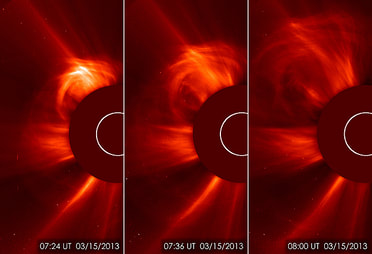
On March 15, 2013, at 2:54 a.m. EDT, the sun erupted with an Earth-directed coronal mass ejection (CME), a solar phenomenon that can send billions of tons of solar particles into space and can reach Earth one to three days later and affect electronic systems in satellites and on the ground. Experimental NASA research models, based on observations from the Solar Terrestrial Relations Observatory (STEREO) and ESA/NASA’s Solar and Heliospheric Observatory, show that the CME left the sun at speeds of around 900 miles per second, which is a fairly fast speed for CMEs. Historically, CMEs at this speed have caused mild to moderate effects at Earth.
The ESA and NASA Solar Heliospheric Observatory (SOHO) captured these images of the sun spitting out a coronal mass ejection (CME) on March 15, 2013, from 3:24 to 4:00 a.m. EDT. This type of image is known as a coronagraph, since a disk is placed over the sun to better see the dimmer atmosphere around it, called the corona
The ESA and NASA Solar Heliospheric Observatory (SOHO) captured these images of the sun spitting out a coronal mass ejection (CME) on March 15, 2013, from 3:24 to 4:00 a.m. EDT. This type of image is known as a coronagraph, since a disk is placed over the sun to better see the dimmer atmosphere around it, called the corona
 RSS Feed
RSS Feed